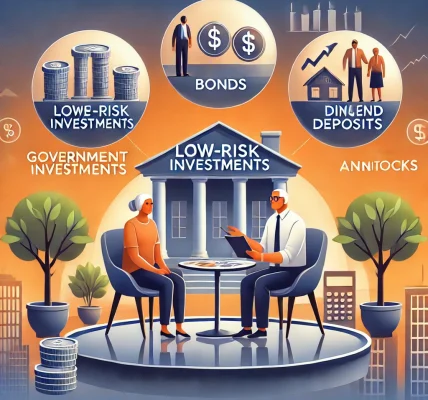Introduction
Retirement planning is a long-term process that requires careful consideration of multiple financial factors. One of the biggest threats to your retirement savings is inflation—the gradual rise in the cost of goods and services over time. Inflation erodes the purchasing power of your money, meaning the amount you save today may not be enough to sustain the same lifestyle in the future.
In this blog, we will explore how inflation impacts retirement savings, why it is essential to factor in inflation when planning, and strategies to protect and grow your retirement funds despite rising prices.
Understanding Inflation and Its Impact on Retirement Savings
What Is Inflation?
Inflation is the rate at which the general level of prices for goods and services rises, decreasing the purchasing power of money. For example, if the inflation rate is 3% per year, a product that costs $100 today will cost $103 next year and $134 in ten years.
How Inflation Affects Retirement Savings
- Reduces Purchasing Power: The money you save today may not have the same value in the future.
- Increases Cost of Living: Everyday expenses like food, healthcare, and housing become more expensive over time.
- Lowers Fixed-Income Value: If you rely on a fixed pension or annuity, inflation reduces the real value of your income.
- Impacts Investment Returns: If your investments do not outpace inflation, your retirement corpus may not grow sufficiently.
Historical Inflation Trends
- The average inflation rate in the United States over the past 50 years has been around 3-4% annually.
- However, some years have seen higher inflation rates, significantly affecting retirees who rely on fixed incomes.
Strategies to Protect Your Retirement Savings from Inflation
1. Invest in Inflation-Protected Securities
One way to safeguard your retirement funds from inflation is by investing in assets specifically designed to combat rising prices.
Options Include:
- Treasury Inflation-Protected Securities (TIPS): These bonds adjust with inflation, ensuring your money keeps its value.
- Inflation-Indexed Annuities: Some annuities offer inflation protection to ensure steady purchasing power.
- Commodities & Real Assets: Investing in gold, real estate, and other commodities can hedge against inflation.
2. Diversify Your Investment Portfolio
A well-diversified portfolio can help mitigate the impact of inflation by spreading risk across different asset classes.
Consider:
- Stocks & Equity Mutual Funds: Historically, stocks have outperformed inflation over the long term.
- Real Estate Investments: Property values and rental income generally rise with inflation.
- Global Investments: Investing in international markets can provide better returns in inflationary periods.
3. Increase Retirement Contributions Over Time
Since inflation reduces the real value of money, increasing your contributions periodically can help maintain your savings’ value.
Actionable Tips:
- Raise your 401(k) or IRA contributions by at least 1-2% each year.
- Adjust your retirement savings goal every few years to account for inflation.
4. Plan for Rising Healthcare Costs
Healthcare expenses tend to rise faster than general inflation, making it essential to prepare for increasing medical costs.
Ways to Prepare:
- Invest in a Health Savings Account (HSA) if eligible.
- Consider long-term care insurance to cover medical expenses in retirement.
- Choose Medicare supplement plans that adjust for inflation.
5. Delay Social Security Benefits
Delaying your Social Security benefits can provide higher payouts adjusted for inflation.
Key Benefits:
- If you claim Social Security at age 70 instead of 62, you receive a higher monthly payout.
- Social Security benefits have cost-of-living adjustments (COLA) that help maintain purchasing power.
6. Consider an Annuity with Inflation Protection
Annuities provide guaranteed income in retirement, but standard annuities do not account for inflation.
Solution:
- Opt for an inflation-adjusted annuity that increases payouts over time.
7. Reduce Unnecessary Expenses in Retirement
Minimizing discretionary spending can help counteract the effects of inflation.
Practical Steps:
- Downsize to a smaller home to reduce housing costs.
- Limit unnecessary luxury expenses like frequent travel or dining out.
- Look for senior discounts and cost-saving programs.
8. Regularly Review and Adjust Your Retirement Plan
Inflation trends can change over time, so regularly reviewing your retirement strategy is essential.
Steps to Take:
- Meet with a financial advisor every few years.
- Rebalance your investment portfolio to maintain inflation-hedged assets.
- Adjust withdrawal rates from your retirement fund based on market conditions.
Conclusion
Inflation is an inevitable part of the economy, but with proper planning and strategic investing, you can protect your retirement savings from its eroding effects.
Summary of Key Takeaways:
✅ Invest in Inflation-Protected Assets like TIPS and real estate. ✅ Diversify Investments with stocks, commodities, and global markets. ✅ Increase Contributions Over Time to maintain purchasing power. ✅ Plan for Healthcare Costs and consider HSAs and Medicare plans. ✅ Delay Social Security Benefits for higher payouts. ✅ Choose Annuities with Inflation Protection to ensure rising income. ✅ Cut Unnecessary Expenses and optimize spending in retirement. ✅ Review and Adjust Your Plan regularly with financial experts.
By implementing these inflation-proof strategies, you can safeguard your retirement savings and ensure a comfortable financial future, regardless of economic fluctuations.




